英文注释
- 格式:doc
- 大小:36.00 KB
- 文档页数:2
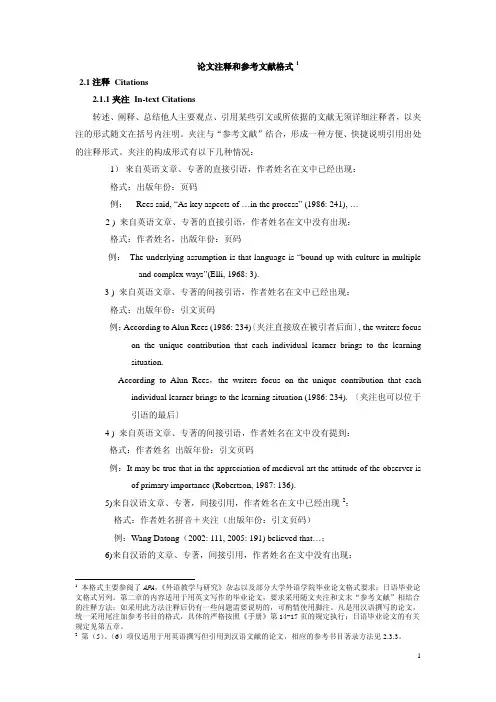
论文注释和参考文献格式12.1注释Citations2.1.1夹注In-text Citations转述、阐释、总结他人主要观点、引用某些引文或所依据的文献无须详细注释者,以夹注的形式随文在括号内注明。
夹注与“参考文献”结合,形成一种方便、快捷说明引用出处的注释形式。
夹注的构成形式有以下几种情况:1)来自英语文章、专著的直接引语,作者姓名在文中已经出现:格式:出版年份:页码例:Rees said, “As key aspects of …in the process” (1986: 241), …2 ) 来自英语文章、专著的直接引语,作者姓名在文中没有出现:格式:作者姓名,出版年份:页码例:The underlying assumption is that language is “bound up with culture in multiple and complex ways”(Elli, 1968: 3).3 ) 来自英语文章、专著的间接引语,作者姓名在文中已经出现:格式:出版年份:引文页码例:According to Alun Rees (1986: 234)〔夹注直接放在被引者后面〕, the writers focus on the unique contribution that each individual learner brings to the learningsituation.According to Alun Rees,the writers focus on the unique contribution that each individual learner brings to the learning situation (1986: 234). 〔夹注也可以位于引语的最后〕4 ) 来自英语文章、专著的间接引语,作者姓名在文中没有提到:格式:作者姓名出版年份:引文页码例:It may be true that in the appreciation of medieval art the attitude of the observer is of primary importance (Robertson, 1987: 136).5)来自汉语文章、专著,间接引用,作者姓名在文中已经出现2:格式:作者姓名拼音+夹注(出版年份:引文页码)例:Wang Datong(2002: 111, 2005: 191) believed that…;6)来自汉语的文章、专著,间接引用,作者姓名在文中没有出现:1本格式主要参阅了APA,《外语教学与研究》杂志以及部分大学外语学院毕业论文格式要求;日语毕业论文格式另列。
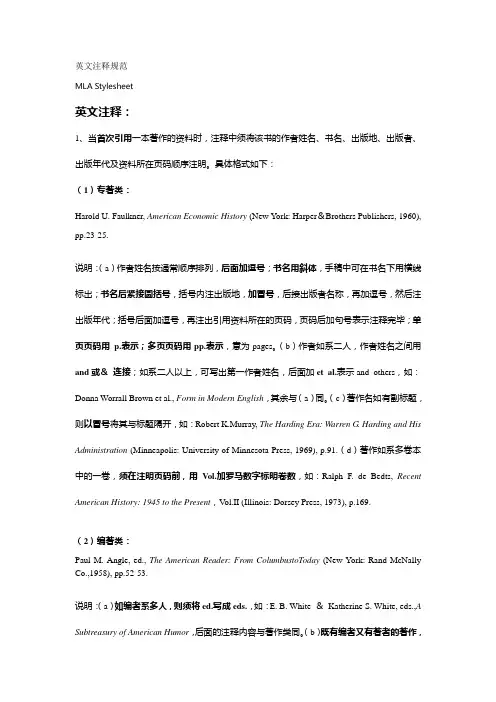
英文注释规范MLA Stylesheet英文注释:1、当首次引用一本著作的资料时,注释中须将该书的作者姓名、书名、出版地、出版者、出版年代及资料所在页码顺序注明。
具体格式如下:(1)专著类:Harold U. Faulkner, American Economic History (New York: Harper&Brothers Publishers, 1960), pp.23-25.说明:(a)作者姓名按通常顺序排列,后面加逗号;书名用斜体,手稿中可在书名下用横线标出;书名后紧接圆括号,括号内注出版地,加冒号,后接出版者名称,再加逗号,然后注出版年代;括号后面加逗号,再注出引用资料所在的页码,页码后加句号表示注释完毕;单页页码用p.表示;多页页码用pp.表示,意为pages。
(b)作者如系二人,作者姓名之间用and或&连接;如系二人以上,可写出第一作者姓名,后面加et al.表示and others,如:Donna Worrall Brown et al., Form in Modern English,其余与(a)同。
(c)著作名如有副标题,则以冒号将其与标题隔开,如:Robert K.Murray, The Harding Era: Warren G. Harding and His Administration (Minneapolis: University of Minnesota Press, 1969), p.91.(d)著作如系多卷本中的一卷,须在注明页码前,用Vol.加罗马数字标明卷数,如:Ralph F. de Bedts, Recent American History: 1945 to the Present,Vol.II (Illinois: Dorsey Press, 1973), p.169.(2)编著类:Paul M. Angle, ed., The American Reader: From ColumbustoToday (New York: Rand McNally Co.,1958), pp.52-53.说明:(a)如编者系多人,则须将ed.写成eds.,如:E. B. White &Katherine S. White, eds.,A Subtreasury of American Humor,后面的注释内容与著作类同。
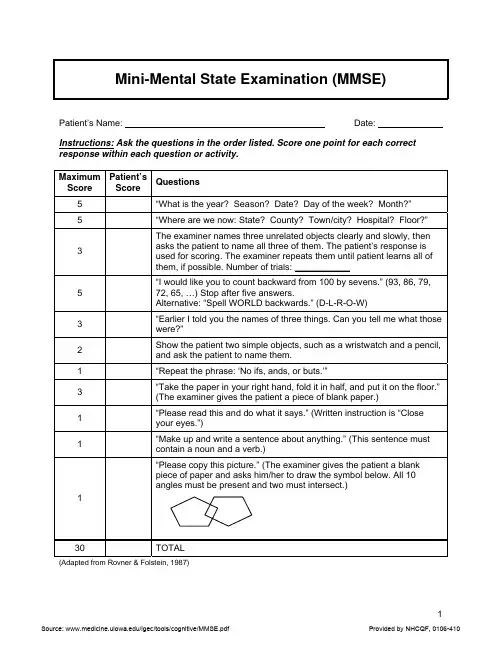
Mini-Mental State Examination (MMSE) Name: Date: Patient’sInstructions: Ask the questions in the order listed. Score one point for each correct response within each question or activity.(Adapted from Rovner & Folstein, 1987)Instructions for administration and scoring of the MMSEOrientation (10 points):•Ask for the date. Then specifically ask for parts omitted (e.g., "Can you also tell me what season it is?"). One point for each correct answer.•Ask in turn, "Can you tell me the name of this hospital (town, county, etc.)?" One point for each correct answer.Registration (3 points):•Say the names of three unrelated objects clearly and slowly, allowing approximately one second for each. After you have said all three, ask the patient to repeat them. The number of objects the patient names correctly upon the first repetition determines the score (0-3). If the patient does not repeat all three objects the first time, continue saying the names until the patient is able to repeat all three items, up to six trials. Record the number of trials it takes for the patient to learn the words. If the patient does not eventually learn all three, recall cannot be meaningfully tested.•After completing this task, tell the patient, "Try to remember the words, as I will ask for them in a little while."Attention and Calculation (5 points):•Ask the patient to begin with 100 and count backward by sevens. Stop after five subtractions (93, 86, 79, 72, 65). Score the total number of correct answers.•If the patient cannot or will not perform the subtraction task, ask the patient to spell the word "world"backwards. The score is the number of letters in correct order (e.g., dlrow=5, dlorw=3).Recall (3 points):•Ask the patient if he or she can recall the three words you previously asked him or her to remember. Score the total number of correct answers (0-3).Language and Praxis (9 points):•Naming: Show the patient a wrist watch and ask the patient what it is. Repeat with a pencil. Score one point for each correct naming (0-2).•Repetition: Ask the patient to repeat the sentence after you ("No ifs, ands, or buts."). Allow only one trial. Score 0 or 1.•3-Stage Command: Give the patient a piece of blank paper and say, "Take this paper in your right hand, fold it in half, and put it on the floor." Score one point for each part of the command correctly executed.• Reading:On a blank piece of paper print the sentence, "Close your eyes," in letters large enough for the patient to see clearly. Ask the patient to read the sentence and do what it says. Score one point only if the patient actually closes his or her eyes. This is not a test of memory, so you may prompt the patient to "do what it says" after the patient reads the sentence.•Writing: Give the patient a blank piece of paper and ask him or her to write a sentence for you. Do not dictate a sentence; it should be written spontaneously. The sentence must contain a subject and a verb and make sense. Correct grammar and punctuation are not necessary.•Copying: Show the patient the picture of two intersecting pentagons and ask the patient to copy the figure exactly as it is. All ten angles must be present and two must intersect to score one point.Ignore tremor and rotation.(Folstein, Folstein & McHugh, 1975)Interpretation of the MMSEMethod ScoreInterpretation Single Cutoff <24 AbnormalRange <21>25Increased odds of dementiaDecreased odds of dementiaEducation21<23<24Abnormal for 8th grade educationAbnormal for high school educationAbnormal for college educationSeverity 24-3018-230-17No cognitive impairmentMild cognitive impairmentSevere cognitive impairmentSources:•Crum RM, Anthony JC, Bassett SS, Folstein MF. Population-based norms for the mini-mental state examination by age and educational level. JAMA. 1993;269(18):2386-2391.•Folstein MF, Folstein SE, McHugh PR. "Mini-mental state": a practical method for grading the cognitive state of patients for the clinician. J Psychiatr Res. 1975;12:189-198.•Rovner BW, Folstein MF. Mini-mental state exam in clinical practice. Hosp Pract. 1987;22(1A):99, 103, 106, 110.•Tombaugh TN, McIntyre NJ. The mini-mental state examination: a comprehensive review. J Am Geriatr Soc.1992;40(9):922-935.。

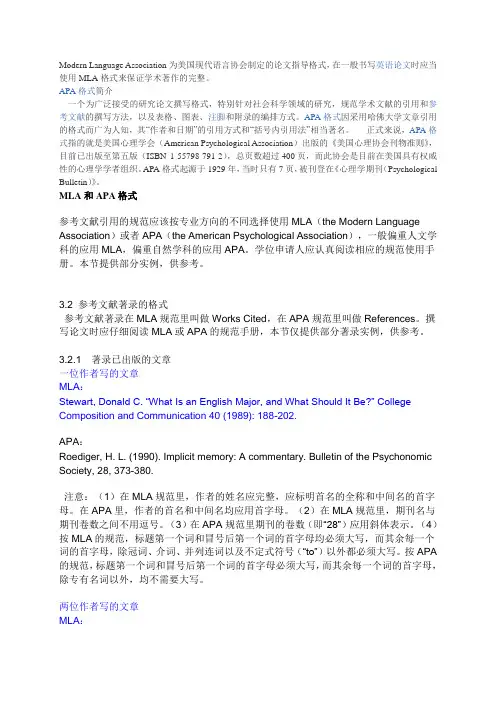
Modern Language Association为美国现代语言协会制定的论文指导格式,在一般书写英语论文时应当使用MLA格式来保证学术著作的完整。
APA格式简介一个为广泛接受的研究论文撰写格式,特别针对社会科学领域的研究,规范学术文献的引用和参考文献的撰写方法,以及表格、图表、注脚和附录的编排方式。
APA格式因采用哈佛大学文章引用的格式而广为人知,其“作者和日期”的引用方式和“括号内引用法”相当著名。
正式来说,APA格式指的就是美国心理学会(American Psychological Association)出版的《美国心理协会刊物准则》,目前已出版至第五版(ISBN 1-55798-791-2),总页数超过400页,而此协会是目前在美国具有权威性的心理学学者组织。
APA格式起源于1929年,当时只有7页,被刊登在《心理学期刊(Psychological Bulletin)》。
MLA和APA格式参考文献引用的规范应该按专业方向的不同选择使用MLA(the Modern Language Association)或者APA(the American Psychological Association),一般偏重人文学科的应用MLA,偏重自然学科的应用APA。
学位申请人应认真阅读相应的规范使用手册。
本节提供部分实例,供参考。
3.2 参考文献著录的格式参考文献著录在MLA规范里叫做Works Cited,在APA规范里叫做References。
撰写论文时应仔细阅读MLA或APA的规范手册,本节仅提供部分著录实例,供参考。
3.2.1 著录已出版的文章一位作者写的文章MLA:Stewart, Donald C. “What Is an English Major, and What Should It Be?” College Composition and Communication 40 (1989): 188-202.APA:Roediger, H. L. (1990). Implicit memory: A commentary. Bulletin of the Psychonomic Society, 28, 373-380.注意:(1)在MLA规范里,作者的姓名应完整,应标明首名的全称和中间名的首字母。
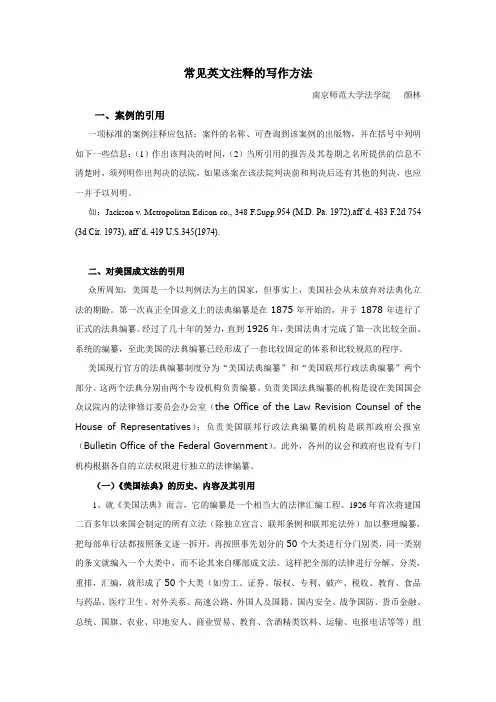
常见英文注释的写作方法南京师范大学法学院颜林一、案例的引用一项标准的案例注释应包括:案件的名称、可查询到该案例的出版物,并在括号中列明如下一些信息:(1)作出该判决的时间,(2)当所引用的报告及其卷期之名所提供的信息不清楚时,须列明作出判决的法院,如果该案在该法院判决前和判决后还有其他的判决,也应一并予以列明。
如:Jackson v. Metropolitan Edison co., 348 F.Supp.954 (M.D. Pa. 1972),aff’d, 483 F.2d 754 (3d Cir. 1973), aff’d, 419 U.S.345(1974).二、对美国成文法的引用众所周知,美国是一个以判例法为主的国家,但事实上,美国社会从未放弃对法典化立法的期盼。
第一次真正全国意义上的法典编纂是在1875年开始的,并于1878年进行了正式的法典编纂。
经过了几十年的努力,直到1926年,美国法典才完成了第一次比较全面、系统的编纂,至此美国的法典编纂已经形成了一套比较固定的体系和比较规范的程序。
美国现行官方的法典编纂制度分为“美国法典编纂”和“美国联邦行政法典编纂”两个部分。
这两个法典分别由两个专设机构负责编纂。
负责美国法典编纂的机构是设在美国国会众议院内的法律修订委员会办公室(the Office of the Law Revision Counsel of the House of Representatives);负责美国联邦行政法典编纂的机构是联邦政府公报室(Bulletin Office of the Federal Government)。
此外,各州的议会和政府也设有专门机构根据各自的立法权限进行独立的法律编纂。
(一)《美国法典》的历史、内容及其引用1、就《美国法典》而言,它的编纂是一个相当大的法律汇编工程。
1926年首次将建国二百多年以来国会制定的所有立法(除独立宣言、联邦条例和联邦宪法外)加以整理编纂,把每部单行法都按照条文逐一拆开,再按照事先划分的50个大类进行分门别类,同一类别的条文就编入一个大类中,而不论其来自哪部成文法。
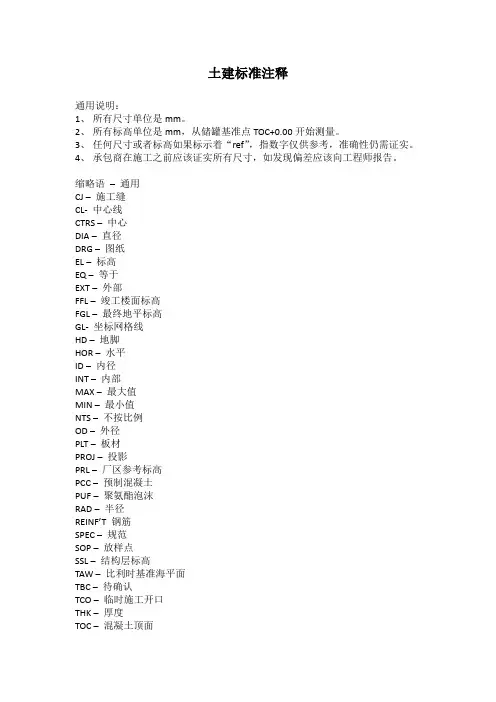
土建标准注释通用说明:1、所有尺寸单位是mm。
2、所有标高单位是mm,从储罐基准点TOC+0.00开始测量。
3、任何尺寸或者标高如果标示着“ref”,指数字仅供参考,准确性仍需证实。
4、承包商在施工之前应该证实所有尺寸,如发现偏差应该向工程师报告。
缩略语–通用CJ –施工缝CL- 中心线CTRS –中心DIA –直径DRG –图纸EL –标高EQ –等于EXT –外部FFL –竣工楼面标高FGL –最终地平标高GL- 坐标网格线HD –地脚HOR –水平ID –内径INT –内部MAX –最大值MIN –最小值NTS –不按比例OD –外径PLT –板材PROJ –投影PRL –厂区参考标高PCC –预制混凝土PUF –聚氨酯泡沫RAD –半径REINF’T 钢筋SPEC –规范SOP –放样点SSL –结构层标高TAW –比利时基准海平面TBC –待确认TCO –临时施工开口THK –厚度TOC –混凝土顶面TOG –灰浆顶面TOS –钢材顶面TPS –热保护系统TYP –相同类型UNO –除非特别注明UOC –混凝土底平面UOS - 钢材底平面U/S –底平面VER –垂直WP –工作点缩略语–钢筋位置ABR –等长相错翻转ABS - 等长相错交替排列AP - 长短交替排列B1 –底面–外层B2 –底面- 第2层B3 –底面–第3层EF –每侧ES- 同样间距EW –每个方向F1 –远面–外层F2 –远面–第2层F3 –远面–第3层LL –长钢筋N1 –近面–外层N2 –近面–第2层N3 –近面–第3层T1 –顶面–外层T2 –顶面–第2层T3 –顶面–第3层钢筋标注:。
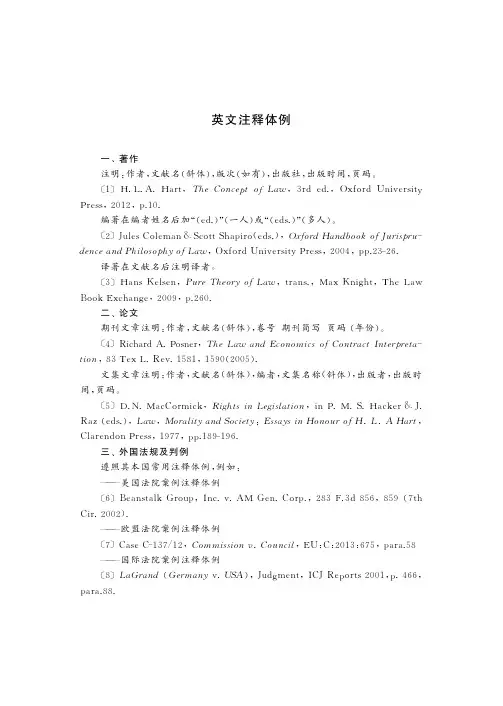
英文注释体例一、著作注明:作者,文献名(斜体),版次(如有),出版社,出版时间,页码。
〔1〕H.L.A.Hart,The Concept of Law,3rd ed.,Oxford UniversityPress,2012,p.10.编著在编者姓名后加“(ed.)”(一人)或“(eds.)”(多人)。
〔2〕Jules Coleman &Scott Shapiro(eds.),Oxford Handbook of Jurispru-dence and Philosophy of Law,Oxford University Press,2004,pp.23-26.译著在文献名后注明译者。
〔3〕Hans Kelsen,Pure Theory of Law,trans.,Max Knight,The LawBook Exchange,2009,p.260.二、论文期刊文章注明:作者,文献名(斜体),卷号期刊简写页码(年份)。
〔4〕Richard A.Posner,The Law and Economics of Contract Interpreta-tion,83Tex L.Rev.1581,1590(2005).文集文章注明:作者,文献名(斜体),编者,文集名称(斜体),出版者,出版时间,页码。
〔5〕D.N.MacCormick,Rights in Legislation,in P.M.S.Hacker &J.Raz(eds.),Law,Morality and Society:Essays in Honour of H.L.A Hart,Clarendon Press,1977,pp.189-196.三、外国法规及判例遵照其本国常用注释体例,例如:———美国法院案例注释体例〔6〕Beanstalk Group,Inc.v.AM Gen.Corp.,283F.3d856,859(7thCir.2002).———欧盟法院案例注释体例〔7〕Case C-137/12,Commission v.Council,EU:C:2013:675,para.58———国际法院案例注释体例〔8〕LaGrand(Germany v.USA),Judgment,ICJ Reports 2001,p.466,para.88. 四、辞书注明:辞书名页码(版次和出版时间)。
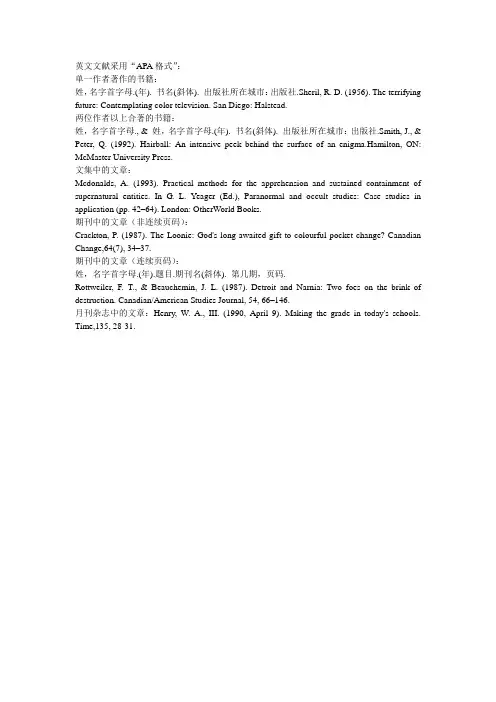
英文文献采用“APA格式”:单一作者著作的书籍:姓,名字首字母.(年). 书名(斜体). 出版社所在城市:出版社.Sheril, R. D. (1956). The terrifying future: Contemplating color television. San Diego: Halstead.两位作者以上合著的书籍:姓,名字首字母., & 姓,名字首字母.(年). 书名(斜体). 出版社所在城市:出版社.Smith, J., & Peter, Q. (1992). Hairball: An intensive peek behind the surface of an enigma.Hamilton, ON: McMaster University Press.文集中的文章:Mcdonalds, A. (1993). Practical methods for the apprehension and sustained containment of supernatural entities. In G. L. Yeager (Ed.), Paranormal and occult studies: Case studies in application (pp. 42–64). London: OtherWorld Books.期刊中的文章(非连续页码):Crackton, P. (1987). The Loonie: God's long-awaited gift to colourful pocket change? Canadian Change,64(7), 34–37.期刊中的文章(连续页码):姓,名字首字母.(年).题目.期刊名(斜体). 第几期,页码.Rottweiler, F. T., & Beauchemin, J. L. (1987). Detroit and Narnia: Two foes on the brink of destruction. Canadian/American Studies Journal, 54, 66–146.月刊杂志中的文章:Henry, W. A., III. (1990, April 9). Making the grade in today's schools. Time,135, 28-31.。

Manifesto of The Communist PartyKarl Marx and Frederick Engels18481 Bourgeois and Proletarians2 Proletarians and Communists3 Socialist and Communist Literature4 Position of the Communists in relation to the various existing opposition partiesA spectre is haunting (“haunt”指“鬼魂等反复出没于某地”。
欧洲的反动势力视共产主义为幽灵,怕得要死。
此句用现在进行时,正活脱脱地表明了他们的这种心理状态,也显示出共产主义方兴未艾,已成气候。
)Europe -- the spectre of communism. All the powers of old Europe have entered into a holy alliance to exorcise this spectre: Pope and Tsar, Metternich and Guizot, French Radicals and German police-spies.Where is the party in opposition (the opposition 指“反对党”,即,the party in opposition。
)that has not been decried as communistic by its opponents in power? Where is the opposition that has not hurled back the branding reproach of communism (reproach指“责骂或责备”,branding 指“玷辱或污辱”,branding reproach则有“诬陷之词”的意思。

本论文注释及参考文献系参考芝加哥大学论文格式要求。
鉴于我校具体情况,为了避免学生混淆,只采取以下一种样式。
报纸文章
如果在论文中出现中文引语内容,应该比照英文引语的方式进行。
其参考文献应另列在英文的参考文献之后,不要编号。
单一作者的书
电子版期刊文章
报纸文章
网址
论文摘要
摘要是论文内容的简介,其要素有4个(目的、方法、结果和结论),必要时也可有其他重要的信息。
要以提供论文内容梗概为目的,在编写时四要素中的方法、结果和结论宜详细,重点是结论,目的可简单。
要在有限的字数内(100-150字左右)提供尽可能多的信息。
编写摘要的注意事项:
1) 要反映论文的新内容和特别强调的观点;
2) 不应对论文内容作解释和评论,尤其不应作自我评价;
3) 不要用第一人称,而应采用第三人称;
4) 不得简单地重复题名中已有的信息;
5) 一般不用引文(除非论文证实或否定了他人已出版的著作);
6) 一般不分段落;
7) 缩略语、略称、代号等,除了相邻专业的读者也能清楚理解的以外,首次出现处必须加以说明。
产品家族:ProductFamily1. 微软:MS:Microsoft ['maikrəusɔft, 'maikrəu.sɔft]2. 软件:SW:Software简包(随机版):coem:Certificate [sə'tifikit, sə'tifəkit]Original Equipment Manufactures [manufactures]3. 彩包(完整包装产品):Full Packaged ['pækidʒd]Product4. 开放式许可:molp:Microsoft open License program5. 教育:AE:academic[.ækə'demik]edition[ɪ'dɪʃən]6. 政府:GORT:government7. 小型数据库(关联式数据库管理系统):Access8. 家庭基础版:Home Basic ['beisik]9. 家庭版(学生版):Home and Student10. 小型企业板(家庭版):Home and Business11. 数据中心:DC:Data ['deitə]Center12. 工作组:Workgroup13. 易捷版:Express14. 网页版:Web15. 开发板:DEV:Develop16. 表格:Excel17. 文档:Word18. 邮件系统:Outlook19. 演示文稿:ppt:PowerPoint20. 数字笔记本:Onenote21. 项目管理:Project22. 系统:Sys:System23. 中心:Ctr:Center24. 服务器:Svr:Server25. 产品许可:Lic:License26. 客户端:Clt:Client:['klaɪənt]27. 管理:Mgmt:Management ['mænidʒmənt]28. 系列,组:Ste:Suite [swi:t]29. 客户端授权(客户访问许可):Cal:Client ['klaiənt] Access License30. 企业发布和营销材料解决方案:Publisher ['pʌbliʃə]31. 开发工具包:VS:Visual ['vizjuəl, 'viʒu:əl] Studio ['stju:diəu, 'stju:di.əu]32. 外设:Ext:External [eks'tə:nl, ik'stə:nəl]33. 连接器:Conn:Connector [kə'nektə]34. 开发虚拟社区:MSDN:Microsoft Developer Network35. 操作系统:OS:Operating ['ɔpəreitiŋ]System36. 远程:Rmt:Remote [ri'məut]37. 桌面:Dsktp:Desktop38. 进程:Svcs:Services39. 零售:Rtl:Retail ['ri:teil]40. 介质访问控制:MAC:Media Access Control41. 酷睿:core [kɔ:, kəur,kɔ:]:英特尔处理器名称42. 企业管理解决方案:SAP:Systems Applications and Products in DataProcessing43. 多语言:MUL:MultiLanguage44. 插件:Plus45. 管理器:Mgr:Manager46. 配置:Config:configuration[kən.figju'reiʃən]47. 操作:Ops:Operations48. 管理授权:ML:ManagementLicense49. 虚拟机监视器:VMM:Virtual ['və:tjuəl, 'və:tʃu:əl]Machine Monitor['mɔnitə, 'mɔnətə]50. 结构化查询语言:SQL:Structured ['strʌktʃəd]Query['kwiəri, 'kwiri]Language51. 中小企业套包(小型企业服务器):SBS:Small Bussiness Server52. 介质:MVL DVD定价级别:V olumeLevel无级别:NL:No Level ['levl, 'levəl]语言版本:Language简体中文:CHNS:Chinese Simplified多语言:ALNG: All Languages单语言(英文):SNGL:Single Language产品类型:ProductType基本版:Essential [i'senʃəl]高级版:Premium ['pri:miəm] Add-On [æd专业版:Pro:Professional [prə'feʃənəl]企业版:Ent:Enterprise ['entəpraiz, 'entə.praiz标准版:Std:Standard ['stændəd旗舰版:Ultimate ['ʌltimit, 'ʌltəmit。
(一)首次引用同中文一般著作注释一样,引用英文资料第一次出现在注释中时,需将资料所在文献的作者姓名、文献名、出版地、出版时间及资料所在页码一并注出。
1、专著Kenneth Waltz, Theories of International Politics ,(Reading, Mass: Addison-Wesley Publishing Company, Inc.,1979),p.81.(作者姓名按通常顺序排列,即名在前,姓在后;姓名后用逗号与书名隔开;书名使用斜体字,手稿中用下划线标出;括号内,冒号前为出版地,后面是出版者和出版时间,如果出版城市不是主要城市,要用邮政中使用的两个字母简称标明出版地所在国,例如UK;单页用p.表示) Hans J.Morgenthau, Politics Among Nations: The Struggle for Power and Peace, 6th ed., (New Y ork: Alfred A. Knopf Inc., 1985), pp. 389-392. (主标题与副标题之间用冒号相隔;多页用pp.表示,意思是pages)Robert Keohane and Joseph Nye, Power and Interdependence: World Politics in Transition, (Boston: Little Brown Company, 1977), pp. 45-46. (作者为两人,作者姓名之间用and 连接;如果为两人以上,写出第一作者,后面加et al., 意思是and others)2、编著David Baldwin, ed. Neorealism and Neoliberalism: The Contemporary Debate, (New Y ork: Columbia University Press, 1993), p.106.Klause Knorr and James N. Rosenau, eds. Contending Approaches to International Politics, (Princeton, New Jersey: Princeton University Press, 1969),pp.225-227.(如编者为多人,须将ed. 写成eds. )3、文集中的文章Robe rt Levaold, “Soveit Learning in the 1980s,” in George W. Breslauer and Philip E. Tetlock, eds. Learning in US and Soviet Foreign Policy, (Boulder, CO: Westview Press, 1991), p.27. (文章名用双引号引上,不用斜体)4、期刊杂志中的文章Joseph S. Nye, “Nuclear learning and US-Soviet Security Regimes,” International Organization, vol. 41 (Summer 1987), p.4 (期刊名用斜体41表示卷号)Rafael V,如注释紧挨着,可以用Ibid.代替作者姓名、著作名。
10天背诵英文10000单词◎教程注释Lesson 11.huddle v.拥挤, 卷缩, 草率从事, 挤作一团n.杂乱的一堆, 拥挤2.censure v.责难n.责难3.vaccine adj.疫苗的, 牛痘的n.疫苗4.eradicate v.根除5.barbarian n.粗鲁无礼的人, 野蛮人adj.野蛮的, 粗鲁的6.defile v.染污n.隘路7.stable n.厩:家畜,尤指马和牛的圈养和喂食的棚子8.abdomen n.腹, 腹部9.bereft adj.被剥夺的, 失去亲人的, 丧失的10.bereave vt. 剥夺, 使失去adj. Suffering the loss of a loved one:忍受失去所爱之人后的痛苦的11.consecrate vt.用作祭祀, 献给, 使神圣adj.被献给神的, 神圣的12.consecrated adj.神圣的, 被视为神圣的13.jolt v.摇晃n.摇晃14.bow n.弓, 乐弓, 弓形, 鞠躬, 船首v.鞠躬, 弯腰15.obsolete adj.荒废的, 陈旧的n.废词, 陈腐的人16.prowl v.巡游17.scoope n.铲子v.掘, 挖18.diplomat n.外交官, 有外交手腕的人, 有权谋的人19.beloved adj.心爱的n.所爱的人, 爱人20.bandit n.强盗21.rug n.(小)地毯, 垫子22.deviation n.背离罗盘偏差:指南针由于局部磁场的影响发生偏移,尤指在船上23.tolerable adj.可容忍的, 可以的24.fortitude n.坚韧25.inconsolable adj.无法安慰的, 极为伤心的26.nibble n. 细咬, 轻咬, 啃v.一点一点地咬, 细咬, 吹毛求疵27.coronation n.加冕礼coronate vt.加冕28.pageant n.盛会, 庆典, 游行, 虚饰, 露天表演29.scourge n.鞭, 笞, 苦难的根源, 灾祸vt.鞭打, 痛斥, 蹂躏30.tumble n.跌倒, 摔跤, 翻斤斗vi.翻倒, 摔倒, 倒塌, 滚动, 翻筋斗, 仓惶地行动vt.使摔倒, 使滚翻, 弄乱pass n.罗盘, 指南针,圆规v.包围32.malicious adj.怀恶意的, 恶毒的33.inauguration n.就职典礼, 开幕式inaugurate vt.举行就职典礼, 创新, 开辟, 举行开幕(落成、成立)典礼.34.afflict vt.使痛苦, 折磨35.dissimulation n.掩饰, 虚伪, 装糊涂36.inhumane adj.残忍的37.flog vt.鞭打, 鞭策, 迫使, 驱使, 严厉批评38.disobedient adj.不服从的39.inscription n.题字, 碑铭40.rummage v.到处翻寻, 搜出, 检查n.翻箱倒柜的寻找, 检查, 零星杂物41.spout n.喷管, 喷口, 水柱, 喷流, 管口v.喷出, 滔滔不绝地讲, 喷涌42.spout out 喷出43.traverse n.横贯, 横断, 横木, 障碍, 否认, 反驳, (建筑)通廊vt.横过, 穿过, 经过, 在...来回移动, 反对, 详细研究vi.横越, 横断, 旋转, 来回移动adj.横断的, 横的44.slope n.斜坡, 斜面, 倾斜v.(使)顺斜45.wistful adj.渴望的, 想望的46.unduly adv.不适当地, 过度地, 不正当地47.meddle v.管闲事48.meddle with 干涉49.amicable adj.友善的, 和平的50.blizzard n.大风雪51.glimmer 暗淡或微弱的闪光52.lump n.块(尤指小块), 肿块, 笨人vt.使成块状, 混在一起, 忍耐, 笨重地移动vi.结块53.ransack vt.到处搜索, 掠夺, 洗劫54.slash(1)乱砍:slash a path through the underbrush.从灌木丛中劈出一条路来(2) 尖刻地批评:The work of the composer has been slashed by the reviewers. 批评家严厉地批评这名作曲家的作品more....55.slumpv.(1)To fall or sink heavily; collapse: 掉入,陷入:沉重地落下或沉下;倒塌:She slumped, exhausted, onto the sofa. 她疲惫之极地倒在沙发上(2)懒散的座着、站着:坐着或站着时垂下;耷拉着(3)To decline suddenly; fall off: 暴跌:突然下降;衰退:Business slumped after the holidays. 节日过后生意下降了(4)To sink or settle, as into mud or slush.( n.烂泥v.溅湿) 陷入:沉入或陷入(泥泞或雪泥中)(5)To slide down or spread out thickly, as mud or fresh concrete. 滑落:将(泥或新拌的混凝土)厚厚地滑下或涂抹开n.(1)The act or an instance of slumping. 陷入,掉入:沉下的动作或事(2)A drooping or slouching posture: 垂下,萎靡:低垂或颓丧的姿式:read defeat in the slump of his shoulders. 从他肩膀的无力下垂上可以看出他失败了(3)A sudden falling off or decline, as in activity, prices, or business: 暴跌:(活动、价格或生意方面)突然的衰退或下降:a stock market slump; a slump in farm prices. 股市暴跌;农产品降格陡降(5)An extended period of poor performance, especially in a sport or competitive activity: 低潮:一段很长的差劲的表演,尤指体育活动或竞赛中:a slump in a batting average. 击球率的低潮期56.carry off v. 夺去...的生命, 获得, 成功对付57.mammalian n.哺乳动物adj.哺乳动物的58.ascribe vt.归因于, 归咎于59.bulwark n.壁垒, 防波堤60.dubious adj.可疑的, 不确定的61.heed n.注意, 留意v.注意, 留意62.mumble n.喃喃而语, 咕哝, 闭嘴细嚼v.喃喃而语, 咕哝63.relic n.遗物, 遗迹, 废墟, 纪念物64.exhaust vt.用尽, 耗尽, 抽完, 使精疲力尽vi.排气n.排气, 排气装adj.用不完的, 不会枯竭的65.fume n.(浓烈或难闻的)烟, 气体, 一阵愤怒(或不安) v.用烟熏, 冒烟, 发怒66.wayfarer n.旅客, 徒步旅行者(同:hiker)67.wont n.习惯, 惯常活动adj.惯于, 常常vi.习惯vt.使习惯于Lesson 268.absolve v.宣布免除69.umpire n.仲裁人, 裁判员v.仲裁, 任裁判, 作裁判70.contend v.(动词)con.tend.ed,con.tend.ing,contendsv.intr.(不及物动词)(1)To strive in opposition or against difficulties; struggle: 争斗:对抗性地或与困难相斗争;斗争:armies contending for control of strategic territory; had to contend with long lines at the airport.军队为了控制战略领地而奋战;在机场必须忍受大排长龙(2)To compete, as in a race; vie. 竞争,如在竞赛中;争夺(3)To strive in controversy or debate; dispute.See Synonyms at discuss争论:在争论或辩论中据理力争;辩论参见discussv.tr.(及物动词)(4)To maintain or assert: 主张或声称:The defense contended that the evidence was inadmissible. 被告方声称证据是不可接受的71.deplore v.表示悲痛72.fracture n.破裂, 骨折v.(使)破碎, (使)破裂73.pith n.(植物的)木髓, 骨髓, 重要部分, 核心, 意义, 精华, 精力vt.除去木髓, 杀死74.relish n.(名词)(1)An appetite for something; a strong appreciation or liking: 胃口:对某事物的食欲,强烈的欣赏或者喜欢:a relish for luxury.对奢侈品的爱好(2)Hearty enjoyment; zest.See Synonyms at zest 诚恳的享乐;风味参见zest(3)Something that lends pleasure or zest. 独特的滋味:使人感到愉快或有风味的东西(4)A spicy or savory condiment or appetizer, such as chutney or olives.调味品:加有香料的或开胃的佐料或开胃品,如辣酱或者橄榄(5)A condiment of chopped sweet pickle. 切碎的甜泡菜做的调味品(6)The flavor of a food, especially when appetizing.See Synonyms at taste滋味:食物的味道,特别是促进食欲的味道参见taste(7)A trace or suggestion of a pleasurable quality. 滋味:令人愉快的微量或意味v.(动词)rel.ished,rel.ish.ing,rel.ish.esv.tr.(及物动词)(1)To take keen or zestful pleasure in.See Synonyms at like 1欣赏:从…中得到敏锐的热烈的欢愉参见like1(2)To enjoy the flavor of. 品尝:品尝…的味道(3)To give spice or flavor to.给…加佐料v.intr.(不及物动词)(1)To have a pleasing or distinctive taste. 有滋味:有令人愉快的或特定的味道75.whip n.鞭子, 车夫v.鞭打, 抽打, 突然移动76.tidings n.消息77.cumber v.tr.(及物动词)cum.bered,cum.ber.ing,cum.bers(1)To weigh down; burden: 压下;使挑重担:was cumbered with many duties. 肩负许多重任(2)To hamper or hinder, as by being in the way: 妨碍,阻碍:妨碍或阻碍,如挡在路上:was cumbered with a long poncho. 披风过长行动就会不便(3)To litter; clutter up: 使凌乱;使塞满:Weeds cumbered the garden paths. 花园小径上到处都是杂草。
给药前prior to treatment详细临床观察前 Prior to Clinical Observations心电 ECG 体温Body temperature 去毛Shaving信息删除Information deletion信息更正Information correction信息添加Information addition拼写错误Spelling mistakesDaily Animal Cageside Observations / 动物日常笼边观察A - No Visible Abnormalities / 无明显异常I - Food Offered / 给过饲料J - Water Offered / 给过水B - Abnormalities Found; Refer to Detailed Clinical Observation form / 发现异常:请参考详细临床观察表C - Animal Found Dead; Refer to Detailed Clinical Observation form / 已死亡的动物:请参考详细临床观察表D - Animal Found Outside of Cage; Refer to Study Director Notification / 在笼外面的动物:请参照专题负责人通知E - Food and Water Available / 有足够食物和水F - Animals fasted for study, but water available / 动物禁食,但不禁水G - Both water and food removed for study purposes / 因试验需要水和食物均不提供H - Water Available and Food Refer to SOP. /有足够的水,依据SOP给食。
体重 Body weights砝码编号Reference Weights No.: LSA-REW-耗食量Food Start/Food EndE - Excluded (A reason for exclusion must be documented) / 被排除在外(必须注明被排除原因)溢出Spillage破损Breakage湿饲料Wet FeedD - Animal died prior to collection of data / 数据收集前动物死亡详细临床观察Clinical Observations详细临床观察前Prior to Clinical ObservationsC - Palpable Tissue Mass(es) Present - Refer to the Palpable Tissue Mass Locations Form / 出现可触及肿块-参考肿块定位表未发现粪便No feces were found.约5ml白色泡沫About 5 ml White foam食物残渣Feed residue包含食物containing food泡沫状foamy液体liquidBasal Laboratory Diet Administration / 动物饲料基础信息领用25kg饲料投入使用25KG diets put in the room.A - Beijing Keao Xieli Feed Co.,Ltd./北京科澳协力饲料有限公司B - Qingdao Kangda Biological Technology Co.,Ltd./青岛康大生物科技有限公司C - Beijing Huafukang Bioscience Co.,Inc./北京华阜康生物科技股份有限公司M - Remaining Diet Discard / 多余饲料丢弃N - Use up / 用完E - Canine Maintenance Feed/犬维持饲料F - SPF Guinea Pig Growth and Reproduction Feed/SPF豚鼠生长繁殖饲料G - Primate Formula Feed/实验猴配合饲料H- SPF Rabbit Special Feed/SPF级实验兔专用饲料I - SPF Rodent Growth and Reproduction Feed/SPF大小鼠生长繁殖饲料J - Swine Maintenance Feed/实验用猪维持饲料K - SPF Rabbit Growth and Reproduction Feed/SPF兔生长繁殖饲料L - SPF Hamster Grouth and Reproduction Feed/SPF地鼠生长繁殖饲料Disposition / 处置:A - Physical abnormality /身体异常B - Excluded by randomization process / 随机排除的动物P - Animal assigned to study / 纳入研究动物E - Euthanized and Discarded via ___________ (method) / 通过__________ (方法)安乐死,丢弃F - Animal used as replacement; refer to replacement animal disposition / 替换动物; 参阅"替代动物处置"G- Cervical dislocation / 颈椎脱臼2 - Prior to euthanasia / 安乐死前1 - Assigning permanent number / 做永久编号4 - Prior to necropsy / 解剖前3 - Prior to blood, urine, or feces collection / 收集血液、粪尿前6 - Found Dead / 发现死亡5 - Following blood collection / 间段性血液收集8 - Found outside of cage / 动物逃出饲养笼7 - Transferring cages / 更换饲养笼17 - Transferred to Necropsy / 转移至解剖组9 - Assigning temporary number and placement into initial housing / 做临时编号、初始安置10 - Prior to ECG examination/blood pressure measurement / 心电图、血压测量前Reasons for Replacement / 替换原因:A - Physical Abnormality / 身体异常B - Animal Found Dead / 动物死亡C - Euthanized in Extremis / 濒临死亡D - Animal Outside Specified Body Weight Range / 动物超出规定体重范围P - Animal Assigned to Study as Replacement Animal / 作为替换动物分配到课题中H - Euthanized and Discarded / 处死并丢弃I - Found Dead and Discarded / 死亡并丢弃动物发现死亡,转移至解剖The animal was found dead and transferred to NEC.设备更换Equipment Change塑料骨头Plastic Bone不锈钢圆筒Stainless Steel Tube代谢笼Metabolism Cage(玉米芯垫料)批号Lot number:动物笼更换Transferring cages更换饲养笼After Transferring cagesA - Food Containers / 食物器皿B - Water Containers / 水瓶C - Animal Caging / 动物笼D - Food Storage Containers / 食物贮存器皿E - Garbage Containers / 垃圾桶F - Enrichment (if used include which type in the comments section) / 玩具(若使用,需在评论中说明是哪种类型)G - Biohazard Containers / 生物有害性物质容器H - Bedding / 垫料I - Water Storage Container / 储水容器J - Cage Shelf / 笼架K - Footrest / 踏板:给药Treatment约ml动物饮用水About ml animal drinking water.空白胶囊1粒One blank capsule胶囊1粒One capsule片剂1片One Tablet给药前轻轻摇匀Shaked slowly before doing.给药前涡旋混匀Vortex mixed before dosingAmount to be dosed / 给药量Dosing Time* / 给药时间*营养品&视觉丰富水果Fruits西瓜watermelon梨pearTelevision Enrichment / 影片观看记录观看影片:海底总动员,开始时间:。
英文短篇阅读文章加注释Daddy just didn't know how to show love. It was Mom who held the familytogether. He just went to work every day and came home; she’d have a list ofsins we’d committed and he'd scold us about them.爸爸根本不知道怎样表达爱。
把这个家维系在一起的人是妈妈。
爸爸天天去上班,回家,然后是妈妈向他数落我们所做的一连串错事,爸爸再为了这些事把我们骂一顿。
Once when I stole a candy bar,he made me take it back and tell the man Istole it and that I' d pay for it. But it was Mom who understood I was just akid.有一次我偷了一根棒棒糖。
爸爸硬是要我送回去,还要我告诉卖糖的人是我偷了糖,并说我愿意帮他拆箱开包作为赔偿。
但妈妈却理解我,她知道我只不过是个孩子。
l broke my leg once on the playground swing and it was Mom who held me inher arms all the way to the hospital. Dad pulled the car right up to the doorof the emergency room and when they asked him to move it saying the space was reserved for emergencyvehicles,He shouted,“What do you think this is? A tour bus?”再有一次,我在操场荡秋千摔坏了腿,一路抱着我到医院的人是妈妈。
【英文注释】a period of indeterminate length (usually short) marked by some action or condition
【短语及搭配】after while 不久,过一会
【例句展示】I will come after while. 我一会就来。
【词汇拓展】conj. 当...的时候;虽然,但是
While I understand what you say, I can’t agree with you.
虽然我理解你的意思,但我还是不同意。
I met her while I was at school. 我在学校的时候遇见了他。
★regret vt. 后悔,遗憾,抱歉
【英文注释】feel sad about the loss or absence of
【短语及搭配】regret to do sth. 遗憾地去做某事regret doing sth. 后悔做过某事
【例句展示】I regret to tell you that you are dismissed. 我遗憾地告诉你,你被解雇了。
I regret telling you that secret. 我后悔告诉你这个秘密。
★far adv. 非常,很,极
【英文注释】to a considerable degree; very much
【短语及搭配】as far as 就...而言
【例句展示】As far as I know, he is kind. 就我所知,他人不错。
Far too busy 太忙碌
To travel far from home 离家去远处旅游
rush v. 冲
【英文注释】cause to occur rapidly
【短语及搭配】rush out of 从...冲出来
【例句展示】The children rushed out of school. 孩子们飞快跑出学校.
act v. 行动
【英文注释】perform an action, or work out or perform (an action)
【例句展示】Think before you act. 三思而后行。
★fright n. 受惊,惊骇
【英文注释】an emotion experienced in anticipation of some specific pain or danger (usually accompanied by a desire to flee or fight)
【短语及搭配】give sb. a fright 使某人受惊
【例句展示】The loud thunder gave me a fright. 这声响雷吓了我一大跳。
【词汇拓展】frighten vt. 吓唬,使惊惧
He was frightened of the fierce dog. 他让这只凶猛的狗吓怕了。
★straight adv. 直接地,一直地
【英文注释】in a forthright manner; candidly or frankly
【短语及搭配】straight away 毫不犹豫地,立刻,马上
【例句展示】Let’s go to the meeting straight away. 我们马上就开会吧.
battered adj. 撞坏的,
【英文注释】damaged by blows or hard usage
【例句展示】a battered car 撞坏的车子 a battered hat 破旧的帽子
shortly adv. 很快地,马上
【英文注释】for a short time
【短语及搭配】shortly afterwards 没过多久,马上
【例句展示】Shortly afterwards, he came back out of breath.
过了没有多久,他上气不接下气地回来了。
afterwards adv. 其后;后来
【英文注释】after that time
【例句展示】She had her supper and went out soon afterwards.
Lesson 35
☆真题操练:◆1~5 DCCCC ◆6~8 BAC。